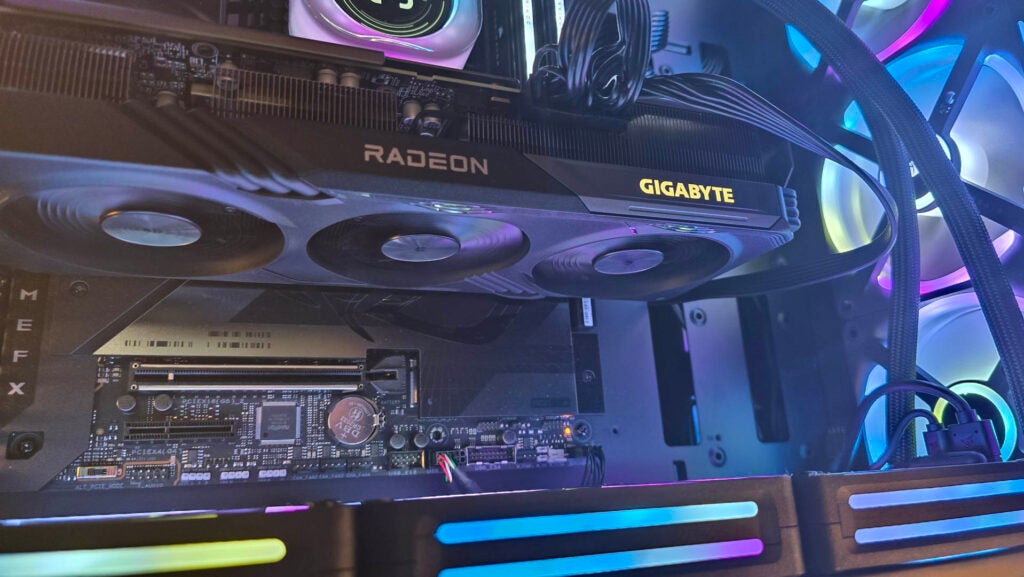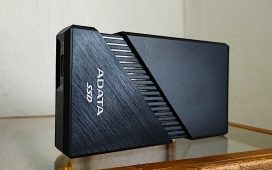Verdict
The AMD Radeon RX 7600 XT is an odd breed of GPU. On the one hand, the extra VRAM provides a lot more head-room in terms of 4K gaming potential, yet on the other, that comes at a fairly significant cost bump in contrast to the likes of the AMD RX 7600, which performs almost identically in both 1080p and 1440p gaming.
Pros
- Solid fps at 1440 and 1080p
- 4K gaming easily hits 30 fps
- 16GB of VRAM future proofs this GPU
Cons
- Gigabyte OC card is quite loud
- Jack of all trades, master of none
-
RDNA 3AMD’s 7000 series GPUs all feature Team Red’s RDNA 3 architecture paired with TSMC’s N6 7nm manufacturing process. -
16GB VRAMThe big difference between the RX 7600 and the 7600 XT is the VRAM bump, notably going from 8 to 16GB. -
FSR 2.0AMD’s answer to DLSS, the RX 7600 XT comes with FSR 2.0 tech as standard, providing excellent AI upscaling tech to help alleviate some 4K frame rate woes.
Introduction
The AMD Radeon RX 7600 XT, on the surface, is an incredibly odd card. By design, there’s not a huge amount of difference when you compare it to its predecessor the RX 7600. In fact, pretty much every single spec on the list is the same.
It features the same amount of shader cores, the same TMUs, the same ROPs, AI Accelerators, Compute Units, the lot. There’s a slight clock-speed tweak, with the XT being bumped up by 100 MHz (which seems to be the trend today with modern GPU refreshes), but that’s about it really.
It’s positioned as an entry-level card, designed to fit perfectly into any 1080p or 1440p gaming PC. But is it the best graphics card option at this price? After weeks of testing, here are my thoughts.
Specs
- RDNA 3 architecture still potent
- AMD’s driver suite is top-tier
- Major change comes in VRAM and power draw
So what has changed compared to the 7600? Well, the major difference between the two cards comes in the form of that VRAM, with the 7600 XT gaining an additional 8GB, taking it to 16GB. On top of that, power draw also jumps up considerably, from 165W to 190W, and of course there’s that 100 MHz clock speed bump as well.
That last point is actually fairly inconsequential sadly, as most RX 7600 cards out there today are pre-binned overclocked variants anyway, the vast majority of which easily match the clock speeds dished out by the 7600 XT.
For my own testing, I utilised Acer’s Predator BiFrost OC RX 7600 8GB card, and Gigabyte’s OC RX 7600 XT 16GB card. The Acer unit maxed out at a staggering 2966 MHz, versus the Gigabyte’s 2949 MHz. Bear in mind that both cards are meant to tap out at 2655 MHz and 2755 MHz respectively.
So why the VRAM bump? Well, that is the question that’s most curious. Let me be clear, this isn’t a 4K graphics card, not on the surface. You could use it to game at 4K, but your mileage is going to vary massively, and you’ll likely only hit 30-40 fps at best, even without ray tracing and with FSR enabled.
That extra 8GB does help in that domain, but the fact it adds an extra $60 to the price tag is a hard pill to swallow for what should be a budget GPU.
Test Setup
I’ve spent the last couple of weeks testing all manner of graphics cards, including AMD’s Radeon RX 7600 XT, to really get to grips with the state of the GPU industry right now.
I’ve pitted these cards against one another in all manner of real-world and synthetic benchmarks, designed to stress them to the absolute limit and give us a good analysis of just how these units work in contrast to their competition. I’ve built a test-bed specifically around one of the best CPUs you can get to eliminate any bottlenecks.
- CPU: Intel Core i9-14900K
- RAM: 32GB (2x16GB) Corsair Dominator Titanium @ 7200
- Motherboard: ASUS ROG Maximus Z790 Dark Hero
- CPU Cooler: Corsair iCUE Link H150i LCD 360mm AIO
- Cooling: 8x Corsair iCUE Link QX120 120mm fans
- PSU: 1200W Corsair RMx Shift 80+ Gold PSU
- SSD: 2TB Gigabyte Aorus Gen5 12000 M.2 PCIe 5.0 SSD
- Case: Geometric Future Model 8 Dharma
For gaming, I’ve used a mix of titles, some that favour AMD, some Nvidia, and a mix of game engines as well, including Vulkan, DX12 and DX11 titles too. All cards are tested at all three key resolutions, and as standard, I’m using the ultra or highest graphical preset for all these benchmarks. In any case where DLSS, FSR or Intel’s XeSS AI upscaling is enabled, I purposely go in and disable those before testing occurs.


For synthetic tests, that’s handled predominantly by both 3D Mark and Blender, with HWMonitor running in the background for temperatures, along with a power meter measuring total system wattage at all times as well.
Performance and Benchmarks
- 1440p is the ideal resolution
- RX 7600 still matches it at 1080p and 1440p
- Overclocking mutes the “performance gain”.
On the whole, gaming performance is generally fairly decent, particularly for a low-end card like the 7600 XT. During my testing at 1080p, Horizon Zero Dawn clocked in 121fps, Shadow of the Tomb Raider averaged 140, and Red Dead Redemption II hit 80 fps as well.
There were some outliers of course, particularly the ray tracing titles with FSR disabled. Cyberpunk pulled down that average frame rate with a stunning 24fps at 1080p, and F1 2022 clocked in at 61fps as well. Although those numbers do dramatically shift if you add FSR to the equation, but more on that shortly.
1440p is a very similar story, albeit with slightly lower frame rates across all titles. The AMD Radeon 7600 XT averaged 60.14 fps across the lot, which is impressive to say the least, comfortably hitting that 60fps sweet spot.
The problem, however, is the standard RX 7600. Our Acer Predator OC variant, with its clock speed already remarkably similar to the XT, managed close to identical performance figures in almost all of my testing. Average frame rate for the XT at 1080p was 87.43, the non-XT 85.86. And at 1440p it averaged 60.14, while the non-XT scored 58.29. Well within margin of error, and certainly beyond noticeable, even by a keen gaming eye.
The difference comes at 4K, with the XT averaging 31.29fps, whereas the non-XT landed only 22.71fps, and that’s with Horizon Zero Dawn failing to finish, with textures running out of VRAM and crashing the benchmark before completion. Generally, the XT averaged anywhere between 30-40 fps in our titles, with only Cyberpunk really pulling those numbers down.
Ray Tracing and Upscaling
- FSR 2.0 performs well, doubling frame rate
- FSR isn’t supported across all titles
- Ray tracing performance generally solid
I also took the liberty to test the AMD Radeon RX 7600 XT across a number of 4K ray traced titles, in a number of different configurations to see how ray tracing and FSR affected performance, and overall I was impressed.
With FSR enabled, F1 2022 for instance doubled its frame rate from 19 to 38, and Cyberpunk went from averaging 6 frames per second to 22 with FSR enabled with Ray tracing as well.
Disable ray tracing and keep FSR on, and those numbers go from 21 up to 50 at 4K, making the RX 7600 XT a genuinely impressive 4K pick, particularly with that extra VRAM, and FSR pumping away in the background.
Power Consumption and Temperature
- Similar power draw to RX 7600
- High temperatures under load
In its stock form we already know the AMD Radeon RX 7600 XT has a slight power draw and clock-speed bump versus the standard RX 7600. Yet, how that translates across in testing is fascinating, particularly given I’m comparing two overclocked variants on these runs.
It ultimately ended up as an incredibly tight race, with the XT averaging 540.6W full system draw under load versus 543.0W for the RX 7600. Idle draw was very similar at 171.4W versus 176.1W as well.
Interestingly it was the temperatures measured that showed the most difference. This may very well be how Gigabyte has configured how its card reports temperature, but the GPU hot spot measured an astonishing 115.0 C, versus the 7600’s 94.0 C. However, comparing the GPU temps alone saw the XT max out at 62.3 C under load versus the 7600’s 75.4 C. Gigabyte’s card, however, was noticeably louder than Acer’s design.
Latest deals
Should you buy it?
You should buy if you want a budget 4K GPU
The AMD Radeon RX 7600 XT is a good 4K gaming GPU, as long as you enable FSR in the titles that support it. Given the price, it makes it competitive without breaking the bank, but without AI upscaling, you’ll run out of runway quickly.
You should not buy if you’re looking for all-around performance
It’s sadly not quite as good value as some of the other options out there, particularly for 1080p and 1440p gaming. In that case, save some cash, and grab the RX 7600 stock variant instead. You’ll have less VRAM, but it’ll match the XT in almost all titles.
Final Thoughts
In isolation, the AMD Radeon RX 7600 XT is a strong 1080p and 1440p card, with legroom to dabble in 4K gaming every now and then. The problem, however, lies in how long that performance will last.
As ray tracing becomes more complex and texture sizes continue to increase, the XT just might not be enough for 4K gaming long term, in which case something like an RTX 4070 Ti Super, may be a better pick for the future. And if you’re sticking to lower resolutions, then the RX 7600 is a better value buy.
The RX 7600 XT isn’t quite the best GPU money can buy right now, but given what AMD has managed to achieve on such an entry-level graphics card with just a touch of extra VRAM and some smart AI upscaling, it’s not far off either.
How we test
Each of the graphics cards we test is installed into a dedicated test-bed. After which point multiple different benchmarks are run to stress test the card, at a variety of different resolutions. We also monitor power draw and temperature throughout this procedure.
Installed in a dedicated test PC
Tested with game benchmarks
Power draw and temperature monitored
FAQs
Although it can achieve 30fps on average at 4K, this does vary massively depending on the game, and whether it supports FSR or not.
Trusted Reviews test data
Peak temperature
Horizon Zero Dawn frame rate (4K)
Horizon Zero Dawn frame rate (Quad HD)
Horizon Zero Dawn frame rate (Full HD)
Cyberpunk 2077 (4K)
Cyberpunk 2077 (Quad HD)
Cyberpunk 2077 (Full HD)
F1 22 (4K)
F1 22 (Quad HD)
F1 22 (Full HD)
Total War: Warhammer 3 (4K)
Total War: Warhammer 3 (Quad HD)
Total War: Warhammer 3 (Full HD)
Power consumption (idle)
Power consumption (under stress)











